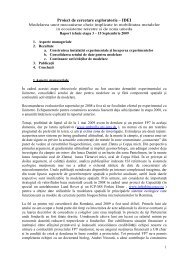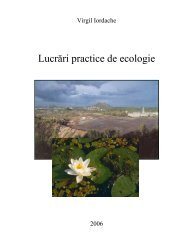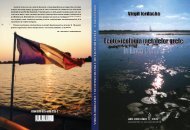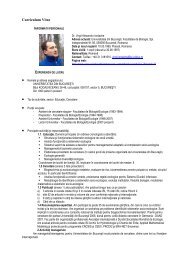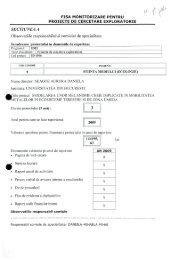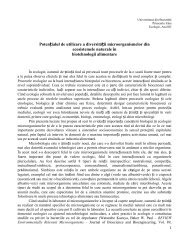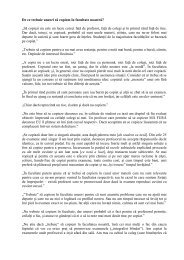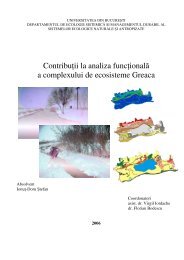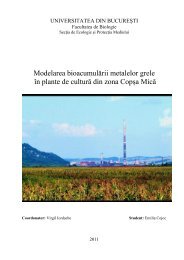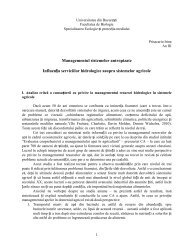Povestea revenirii mele - uefiscdi
Povestea revenirii mele - uefiscdi
Povestea revenirii mele - uefiscdi
Create successful ePaper yourself
Turn your PDF publications into a flip-book with our unique Google optimized e-Paper software.
62<br />
să vin la Arad în cadrul Universităţii “Aurel Vlaicu”.<br />
Apoi a urmat un schimb de corespondenţă cu decanul<br />
Facultăţii de Inginerie Alimentară, Turism şi Protecţia<br />
Mediului din cadrul acestei universităţi, în urma căreia<br />
împreună cu soşul meu am decis să revenim în ţară<br />
căci am putea realiza cel puţin la fel de multe ca şi în<br />
străinătate. Posibilitatea de revenire în ţară oferită de<br />
programul CEEX, a fost încununată de succes, iar din<br />
octombrie 2005 desfăşor activităţi didactice şi de cercetare<br />
la Universitatea “Aurel Vlaicu” din Arad.<br />
Relatarea succintă a începerii<br />
derulării proiectului (sprijin acordat,<br />
obstacole întâmpinate)<br />
În cadrul proiectului am început activitatea de<br />
cercetare în octombrie 2005, imediat ce am revenit în<br />
ţară, iar pe parcursul derulării acestuia am avut<br />
deosebita plăcere să constat că pentru orice neclaritate<br />
sau problemă apărută am avut tot sprijinul celor<br />
de la Autoritatea Contractantă.<br />
Obstacolele întâlnite au fost legate mai mult de<br />
timpul lung de livrare al reactivilor sau al consumabilelor,<br />
ceea ce în străinătate nu reprezentă o proble -<br />
mă căci cel mai lung timp de livrare al reactivilor era<br />
de maximum 10 zile.<br />
Scurtă prezentare a proiectului de cercetare<br />
Poluarea mediului are o mare influenţă asupra<br />
sănătăţii omului şi de aceea poate fi considerată ca<br />
fiind un factor de mare importanţă în calitatea vieţii. În<br />
funcţie de rezultatul dorit, metode sensibile şi selective<br />
sunt necesare atât pentru determinare calitativă<br />
cât şi cantitativă a analiţilor de interes. Astfel de tehnici<br />
sunt deja în număr foarte mare. Totuşi, cerinţele de<br />
cost scăzut, timp mic de analiză, sensibilitate, simplitate,<br />
selectivitate, stabilitate şi fiabilitate nu pot fi<br />
îndeplinite de către o singură metodă de analiză.<br />
Tehnicile bazate pe biorecunoastere sunt posibile<br />
candidate ce pot îndeplini multe din cerinţele mai sus<br />
enumerate, datorită faptului că în general aceste<br />
tehnici prezintă atât selectivitatea şi sensibilitatea<br />
adecvată, cât şi viteza de interacţie mărită între componentul<br />
biologic şi analit.<br />
În cazul enzimelor redox, transferul de electroni<br />
poate fi studiat atât din punct de vedere fundamental<br />
cât şi al posibilelor aplicaţii în construirea biosenzorilor.<br />
O deosebită atenţie în cadrul acestui proiect a<br />
fost acordată investigării transferului heterogen de<br />
electroni cât şi în interiorul proteinei enzimelor<br />
folosind electrozi metalici sau de cărbune pentru a se<br />
elucida relaţia dintre proprietăţile cinetice şi termodinamice<br />
ale acestor enzime, şi corelarea acestora cu<br />
eficienţa enzimelor de a degrada diverşi poluanţi.<br />
Aceste enzime redox pot fi deasemenea folosite pentru<br />
realizarea unor biosensori specifici pentru detecţia<br />
poluanţilor.<br />
Ţelul acestui proiect a fost acela de a dezvolta şi<br />
implementa biosenzorii şi noi tehnici bioanalitice în<br />
this university. After some letter exchanges with the<br />
Dean of Faculty of Food Engineering, Tourism and<br />
Environemntal Protection, my husband and I decided<br />
to return to Romania because we considered that we<br />
can achieve at least as much as we did abroad. The<br />
possibility to return offered by the CEEX programme<br />
was successful and since October 2005 I have been<br />
doing teaching and reasearch activities at University<br />
“Aurel Vlaicu” of Arad.<br />
Brief presentation<br />
of the project implementation (support<br />
received,obstacles encountered)<br />
Within the research project I started the research<br />
activity in October 2005, as soon as I got back to<br />
Romania, and during the project I had the pleasure to<br />
discover that for any question or problem that<br />
appeared I had the full support of the people from the<br />
Contracting Authority.<br />
The obstacles I found during the project were<br />
regarding the long delivery time of the chemicals or<br />
consumables, which I did not meet while being abroad<br />
where the longest delivery time was of maximum 10<br />
days.<br />
Summary of the project<br />
Environmental pollution has an impact on human<br />
health and can therefore be considered being connected<br />
to life quality. Depending on the purpose, sensitive<br />
and selective methods are needed for both<br />
quantitative and qualitative determination of target<br />
analytes.<br />
Numerous such techniques are already available.<br />
However, the requirements for low cost, short time of<br />
analysis, sensitivity, simplicity, selectivity, stability and<br />
reliability can still not be met by a single analytical<br />
method.<br />
Biorecognition-based techniques are potential<br />
candidates to fulfil many of the above requirements,<br />
due to the general high selectivity, sensitivity and<br />
speed of interaction between the biological component<br />
and the analyte itself.<br />
Electron-transfer (ET) reactions of redox proteins<br />
and enzymes were studied for fundamental reasons<br />
and for possible application in biosensors. Research<br />
was focused on investigation of the heterogeneous<br />
and intra-protein ET of ligninolytic enzymes (such as<br />
laccase) using metal and carbon electrodes to find<br />
correlations between kinetic and thermodynamic<br />
properties of these enzymes with their efficiency of<br />
pollutants degradation. These and other redox<br />
enzymes were used to develop biosensors for specific<br />
detection of different pollutants.The goal of this project<br />
was to develop and demonstrate biosensors,<br />
chemical sensors, and novel bioanalytical techniques<br />
for potential environmental applications.<br />
The research areas included the use of molecularly<br />
imprinted polymers for detection of pesticides,<br />
<strong>Povestea</strong> <strong>revenirii</strong> <strong>mele</strong> - domeniul chimie



